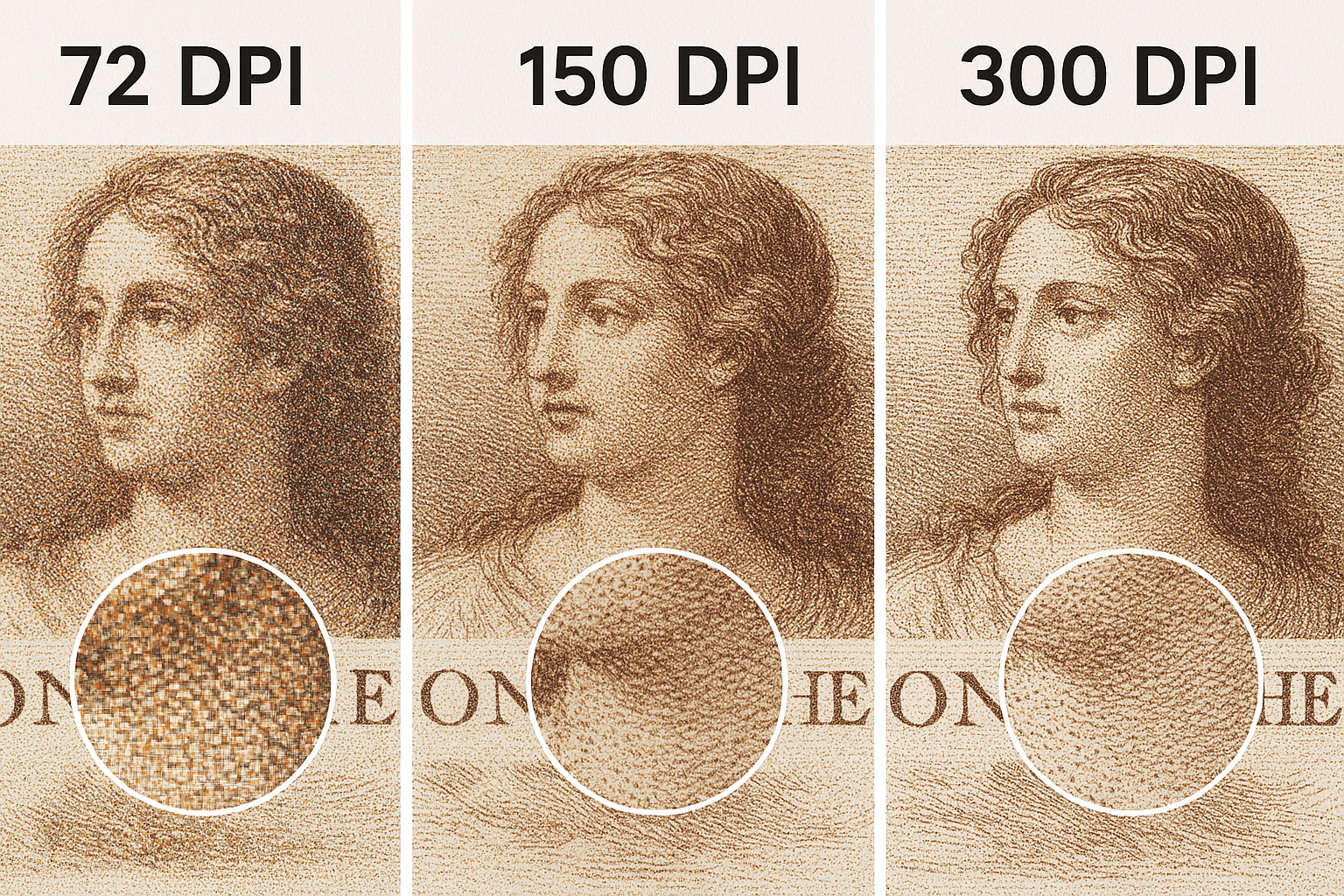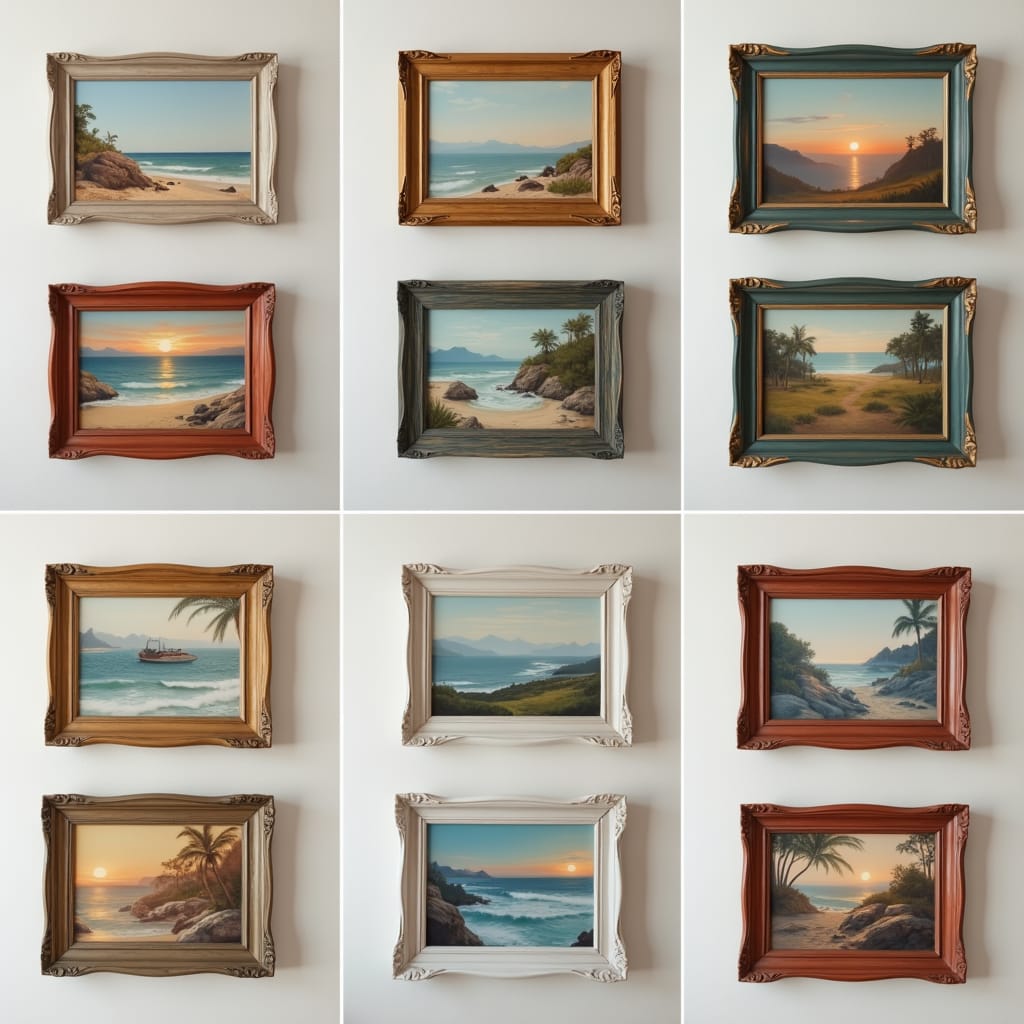Whether you’re creating art prints for your online shop, decorating your home, or promoting an event, understanding poster sizes is essential for making professional decisions. From the tiny flyer on your bulletin board to the massive movie poster at your local cinema, each poster size serves a specific purpose—and choosing the right one can make or break your project.
Key Points Summary:
- Standard US poster sizes range from 8.5×11 inches to 40×60 inches, with 24×36 being the most popular large format
- ISO A-series sizes (A0-A4) dominate international markets and use the mathematically perfect 1:√2 aspect ratio
- Professional art prints require 300 DPI resolution to avoid pixelation and maintain quality
- Matting adds double the mat width to both dimensions (a 2-inch mat on an 18×24 print requires a 24×30 frame)
- Aspect ratio compatibility prevents unwanted cropping when scaling images
Understanding Standard Poster Sizes: US and International Measurements

Poster sizes aren’t random—they’re carefully standardized to match frame availability and printing equipment. The two main systems are the US Imperial standard and the international ISO 216 metric standard. Let’s break down both so you know exactly which size fits your needs.
Small Format Posters: Perfect for Everyday Use
8.5″ × 11″ (Letter Size)
The smallest standard poster size is actually the same as regular printer paper. It’s incredibly popular for flyers, announcements, and small informational posters. You’ll see these everywhere—on community bulletin boards, in classroom windows, and taped to lampposts. Because this size uses standard paper, it’s incredibly cheap to produce in high volumes.
The international equivalent is A4 (210 × 297 mm or 8.3 × 11.7 inches), which you’ll encounter throughout Europe, Asia, and most countries outside North America.
11″ × 17″ (Bulletin or Mini Poster)
This size, often called “tabloid” in printing terms, doubles the area of letter-size paper. It’s the go-to choice for restaurant menus, small event promotions, and retail window displays. The slightly larger canvas gives you enough space to include eye-catching graphics without overwhelming your message.
The comparable metric size is A3 (297 × 420 mm or 11.7 × 16.5 inches). Many artists working with color theory use these smaller formats for test prints before committing to larger sizes.
Medium Format Posters: The Sweet Spot for Home Décor
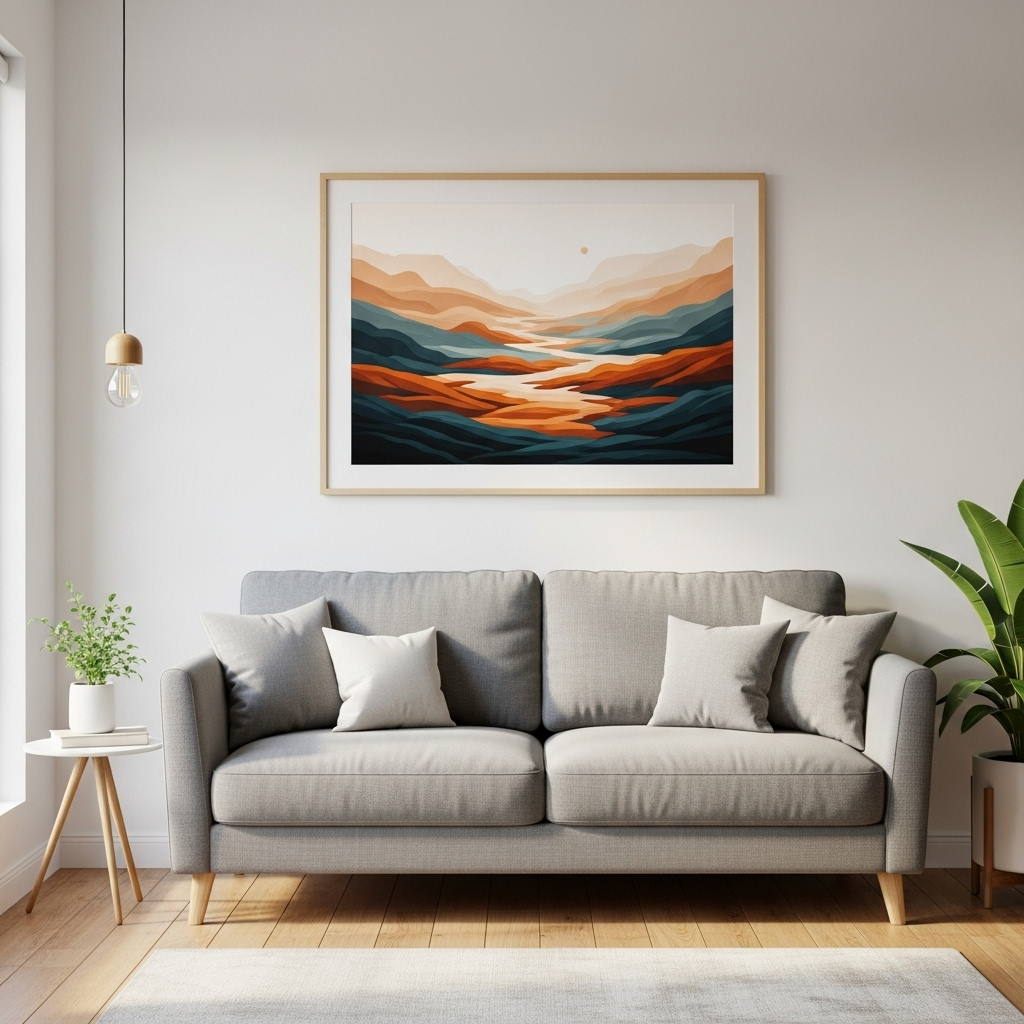
18″ × 24″ (Medium Poster)
Now we’re talking serious wall art. The 18×24 poster hits the perfect balance between impact and practicality. It’s large enough to make a statement but not so big that it dominates a room. This size is wildly popular for concert posters, art prints, and photography.
When choosing canvas for your art, many artists prefer this dimension because it maintains the classic 3:4 aspect ratio—the same proportions used in traditional photography and digital screens. This ratio feels naturally balanced to the human eye.
For artists creating original work, understanding essential elements of composition becomes crucial at this size, as viewers can see more detail and nuance in your work.
Large Format Posters: Maximum Visual Impact
24″ × 36″ (Large or Standard Poster)
This is the king of poster sizes. Walk into any frame shop or poster store, and you’ll find more 24×36 options than any other size. Why? It’s the perfect size for commercial displays, trade show graphics, retail promotions, and serious home décor.
The 24×36 dimension follows a 2:3 aspect ratio, which matches the output from most digital cameras and design software. This compatibility makes it incredibly popular with photographers and digital artists. When you’re creating digital artwork, designing in this aspect ratio ensures your work translates perfectly to print.
The closest international equivalent is A1 (594 × 841 mm or 23.4 × 33.1 inches), which you’ll find throughout Europe and Asia.
27″ × 40″ (Movie One-Sheet)
Here’s where things get specialized. This precise dimension is the standard for modern movie posters in cinemas. Walk into any theater lobby, and every promotional poster you see will be exactly 27×40 inches.
“The movie poster size evolved from theatrical traditions and became standardized in the 1980s. Before that, classic film posters measured 27×41 inches—just one inch taller. This seemingly tiny difference matters enormously to collectors hunting for vintage frames.”
Film Memorabilia Association
If you’re a collector, this distinction is critical. Pre-1980s movie posters won’t fit in standard 27×40 frames without professional modification. Many art galleries and museums display vintage posters in custom frames to preserve these historical dimensions.
40″ × 60″ (Extra Large Format)
At the extreme end sits the 40×60 poster—massive enough for bus shelter advertising, subway platforms, and outdoor promotional campaigns. At this scale, print quality becomes absolutely critical, which we’ll discuss in the resolution section below.
The ISO 216 System: International Standard Poster Sizes

While North America relies on Imperial measurements, most of the world uses the ISO 216 metric standard. This system is elegantly mathematical and incredibly practical for artists and designers.
The Mathematical Beauty of the √2 Ratio
The entire ISO 216 system is built on one brilliant principle: every paper size in the A-series has an aspect ratio of 1:√2 (approximately 1:1.414). This might sound like abstract math, but it creates a powerful real-world benefit.
When you cut an A0 sheet in half parallel to its shorter side, you get two perfect A1 sheets. Cut an A1 in half, and you get two A2 sheets. This pattern continues all the way down to A4 and beyond. Most importantly, every single size maintains the exact same proportions.
For artists and designers, this is incredibly valuable. You can create one design and scale it perfectly across the entire range—from tiny A4 handbills to massive A0 exhibition prints—without any cropping, distortion, or reformatting. When planning your composition, this consistency saves enormous time and effort.

A-Series Dimensions and Their Uses
A0 (841 × 1189 mm / 33.1 × 46.8 inches)
The grandfather of the A-series, A0 has exactly one square meter of surface area. Engineers and architects use this size for technical drawings and blueprints. Large-scale art exhibitions also favor A0 for maximum visual impact.
A1 (594 × 841 mm / 23.4 × 33.1 inches)
This is the international equivalent of the US 24×36 standard poster. A1 posters dominate European retail displays, university lecture halls, and art galleries. If you’re selling art online internationally, offering A1 prints alongside US sizes dramatically expands your market.
A2 (420 × 594 mm / 16.5 × 23.4 inches)
A popular medium format for photo posters, restaurant menus, and moderate-sized wall art. Artists creating watercolor paintings often find A2 provides enough space for detail work without becoming overwhelming.
A3 (297 × 420 mm / 11.7 × 16.5 inches)
Roughly equivalent to US 11×17, A3 is perfect for smaller promotions, portfolio prints, and office displays.
A4 (210 × 297 mm / 8.3 × 11.7 inches)
The standard document size worldwide. While technically a paper size, A4 frequently appears in poster contexts for small-scale promotions and handouts.
B-Series: The Middle Ground
The B-series provides intermediate sizes between A-series dimensions. For example, B1 (707 × 1000 mm) fills the gap between A1 and A0. In countries like Germany and Japan, B1 is the standard movie poster size, while the US uses 27×40 inches.
Complete Poster Sizes Chart: Quick Reference Guide
| Poster Size | US Dimensions (inches) | Metric Dimensions (mm) | Closest ISO Size | Aspect Ratio | Primary Use |
|---|---|---|---|---|---|
| Letter/Small | 8.5 × 11 | 215.9 × 279.4 | A4 (210 × 297) | 1:1.3 | Flyers, announcements |
| Bulletin/Mini | 11 × 17 | 279.4 × 431.8 | A3 (297 × 420) | 1:1.54 | Small retail ads, menus |
| Medium | 18 × 24 | 457.2 × 609.6 | B2 (500 × 707) | 3:4 | Concert posters, home décor |
| Large/Standard | 24 × 36 | 609.6 × 914.4 | A1 (594 × 841) | 2:3 | Retail displays, art prints |
| Movie One-Sheet | 27 × 40 | 685.8 × 1016 | B1 (707 × 1000) | 27:40 | Film promotion |
| Extra Large | 40 × 60 | 1016 × 1524 | B0 (1000 × 1414) | 2:3 | Outdoor advertising |
Understanding Aspect Ratio for Print Quality
Aspect ratio might sound technical, but it’s simply the relationship between a poster’s width and height. Getting this right prevents disaster when you print your designs.
Why Aspect Ratio Matters
Imagine you’ve created a beautiful square design and decide to print it on a 24×36 poster. Problem: 24×36 isn’t square—it’s rectangular with a 2:3 ratio. Your printer must either:
- Crop your design — chopping off portions of your image
- Add white borders — leaving awkward blank spaces
- Stretch or squeeze — distorting your carefully composed artwork
None of these options are acceptable. The solution? Design with your final dimensions in mind from the very beginning.
Common Aspect Ratios in Art and Design
2:3 Ratio — Used in 24×36 and 40×60 posters. This is the most popular commercial poster ratio and matches most digital camera outputs. When working with digital painting techniques, starting with a 2:3 canvas prevents scaling issues.
3:4 Ratio — Found in 18×24 posters and traditional photography. Many artists prefer this slightly taller format for portrait-oriented work. Understanding portrait painting proportions helps when working at this ratio.
4:5 Ratio — Common in smaller photo prints like 8×10 and 16×20. Less common for posters but essential to know if you’re adapting photographs.
1:√2 Ratio — The ISO 216 standard (approximately 1:1.414). Perfect for scalable international designs.
Checking Aspect Ratio Compatibility
Here’s a simple formula to check if two dimensions share the same aspect ratio:
Width₁ ÷ Height₁ = Width₂ ÷ Height₂
For example:
- 18×24: 18 ÷ 24 = 0.75 (3:4 ratio)
- 24×36: 24 ÷ 36 = 0.67 (2:3 ratio)
These ratios don’t match, so an 18×24 design won’t scale perfectly to 24×36 without cropping or borders.
Print Resolution and DPI: The Technical Foundation
Resolution determines whether your poster looks crisp and professional or pixelated and amateurish. Understanding DPI (dots per inch) is non-negotiable for serious print work.
What Is DPI and Why 300 Is the Magic Number
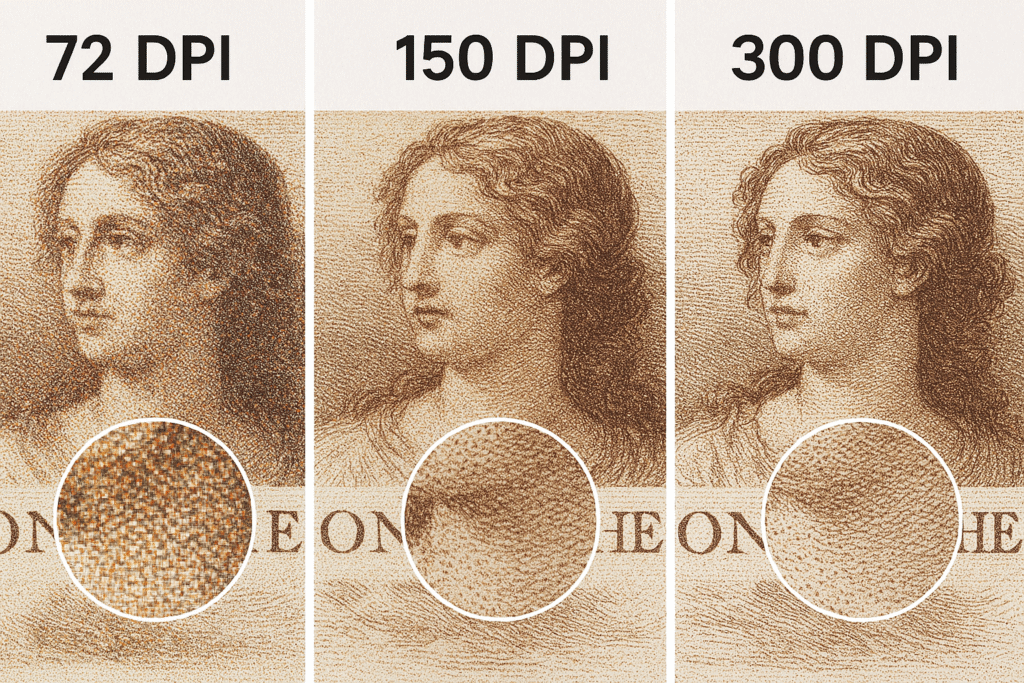
DPI measures how many individual ink dots a printer places within one linear inch. Higher DPI equals finer detail and sharper images.
For professional art prints and photographs, 300 DPI is the industry standard. This resolution ensures that fine details, smooth gradients, and subtle textures reproduce accurately. At viewing distances of one to two feet, the human eye can distinguish individual dots at resolutions below 300 DPI, making prints appear grainy or blurry.
In contrast, web images typically use 72 DPI—perfectly adequate for screens but disastrous for printing. If you try printing a 72 DPI web image at poster size, you’ll end up with a blurry, pixelated mess.
Calculating Required Pixel Dimensions
To maintain 300 DPI quality, your digital file must contain enough pixel information. The calculation is straightforward:
Required Pixels = Dimensions (inches) × 300 DPI
For example, a 24×36 inch poster requires:
- Width: 24 × 300 = 7,200 pixels
- Height: 36 × 300 = 10,800 pixels
- Total file: 7,200 × 10,800 pixels
That’s a 77.76-megapixel image—far larger than most digital cameras produce! This is why many artists work digitally at these massive resolutions or scan their traditional paintings at professional print shops.
Poster Size Calculator Pro
Professional tools for print resolution, aspect ratios, framing, and more
How to Use These Tools
- 1
DPI & Resolution: Enter your poster dimensions and desired DPI to calculate required pixel dimensions for sharp printing.
- 2
Aspect Ratio: Compare two sets of dimensions to check compatibility—avoid unwanted cropping when resizing images.
- 3
Matting & Framing: Input your print size and mat width to determine the exact frame size needed for proper mounting.
- 4
Scale Calculator: Enter current dimensions and new width to get proportional height—perfect for maintaining image quality during resizing.
DPI & Pixel Resolution Calculator
Calculate the required pixel dimensions for professional print quality
Poster Dimensions
Results
Professional Quality: Perfect for art prints.
Resolution Requirements by Poster Size
| Poster Size (inches) | Minimum Pixels at 300 DPI | File Size Estimate | Context |
|---|---|---|---|
| 11 × 17 | 3,300 × 5,100 | ~16.8 MP | High-quality bulletin |
| 18 × 24 | 5,400 × 7,200 | ~38.9 MP | Professional art print |
| 24 × 36 | 7,200 × 10,800 | ~77.8 MP | Gallery-quality standard |
| 27 × 40 | 8,100 × 12,000 | ~97.2 MP | Cinema poster quality |
| 40 × 60 | 12,000 × 18,000 | ~216 MP | Large format advertising |
When You Can Use Lower Resolution
There’s one important exception: viewing distance. Massive posters intended for outdoor advertising or bus shelter displays are typically viewed from 10-20 feet away. At that distance, the human eye cannot distinguish individual pixels at lower resolutions, so 150 DPI often suffices for very large formats.
However, for art prints, photography, and any poster viewed up close, never compromise on 300 DPI quality. Artists working in watercolor techniques or acrylic painting especially need high resolution to capture brush strokes and texture detail.
Framing Your Poster: Sizes, Matting, and Display
Selecting the right poster size is only half the battle. Proper framing transforms a simple print into a professional presentation that protects and enhances your artwork.
Standard Frame Sizes and Compatibility
Frame manufacturers produce standard sizes to match the most popular poster dimensions. In the US market, you’ll easily find ready-made frames in these sizes:
- 8×10, 11×14, 11×17
- 16×20, 18×24, 20×24
- 24×36, 27×40
- 30×40, 40×60
When you frame a poster without matting, choose a frame that matches your poster size exactly. Professional frames include a small lip (called a rabbet) that overlaps the print edge by about half an inch, holding the artwork securely in place while concealing any rough edges.
For those interested in framing and varnishing finished paintings, the same principles apply whether you’re framing prints or original work.
The Art of Matting: Size Calculations
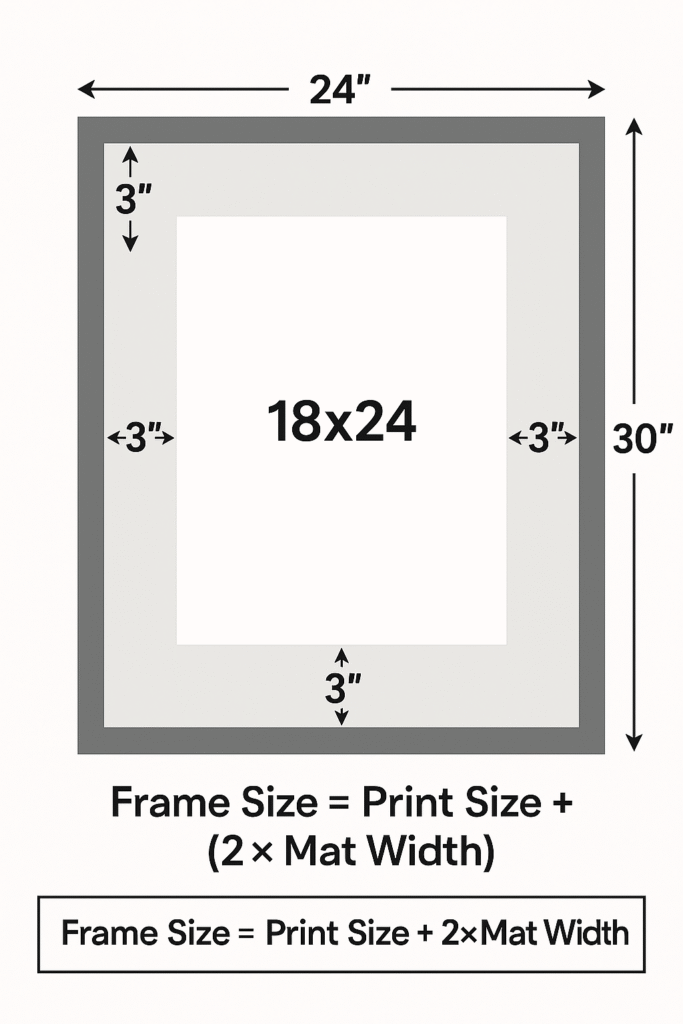
Matting—the border material around your artwork—serves both aesthetic and protective functions. It creates visual breathing room, draws the eye toward the artwork, and prevents the print from touching the glass, which can cause damage over time.
The Critical Rule: Matting Doubles the Dimension Increase
When you add a mat, you’re adding material to all four edges of your artwork. This means the total increase in frame size equals double the mat width for both dimensions.
Formula: Frame Size = Print Size + (2 × Mat Width)
Practical Matting Examples
Example 1: 8×10 Print with 2-Inch Mat
- Print: 8×10 inches
- Mat width: 2 inches on all sides
- Required frame: 8 + (2×2) by 10 + (2×2) = 12×14 inches
Example 2: 18×24 Print with 3-Inch Mat
- Print: 18×24 inches
- Mat width: 3 inches on all sides
- Required frame: 18 + (2×3) by 24 + (2×3) = 24×30 inches
Example 3: 20×30 Print with 5-Inch Mat (Gallery Style)
- Print: 20×30 inches
- Mat width: 5 inches on all sides
- Required frame: 20 + (2×5) by 30 + (2×5) = 30×40 inches
This generous matting creates a dramatic, high-end gallery presentation with substantial negative space around the artwork.
Matting Style Guide by Use Case
| Print Size | Frame (No Mat) | Mat Width | Final Frame Size | Style/Context |
|---|---|---|---|---|
| 11 × 14 | 11 × 14 | 2.5 inches | 16 × 20 | Entry-level framing |
| 16 × 20 | 16 × 20 | 2 inches | 20 × 24 | Standard home décor |
| 18 × 24 | 18 × 24 | 3 inches | 24 × 30 | High-end gallery look |
| 20 × 30 | 20 × 30 | 5 inches | 30 × 40 | Dramatic focal point |
| 24 × 36 | 24 × 36 | 2 inches | 28 × 40 | Oversized gallery |
When planning artwork display for interior design, these calculations ensure your framing budget and wall space align perfectly.
Professional Display Tips
Avoiding the “Floating Postage Stamp” Effect
One of the most common décor mistakes is hanging a tiny piece of art alone on a massive wall. The artwork appears lost and insignificant, creating an unbalanced, incomplete look.
Solutions:
- Scale appropriately — Artwork should occupy roughly 60-75% of the width of the furniture below it
- Create gallery walls — Group multiple smaller pieces to create one large visual unit
- Use odd numbers — Collections of 3, 5, or 7 pieces feel more dynamic than even numbers
- Anchor with furniture — Position artwork above sofas, desks, or console tables to ground the display
Gallery Wall Spacing
When creating a gallery wall with multiple pieces, consistency in spacing is crucial. Professional designers typically maintain 2-4 inches (5-10 cm) between frames. Too close appears cramped; too far appears disconnected.
Treat the entire arrangement as a single large rectangle. Lay out all pieces on the floor first, measuring the total dimensions of your arrangement. Then map that rectangle onto your wall, ensuring the center of your arrangement sits at eye level (typically 57-60 inches from the floor).
Many contemporary artists use gallery wall arrangements to display series or thematically connected work.
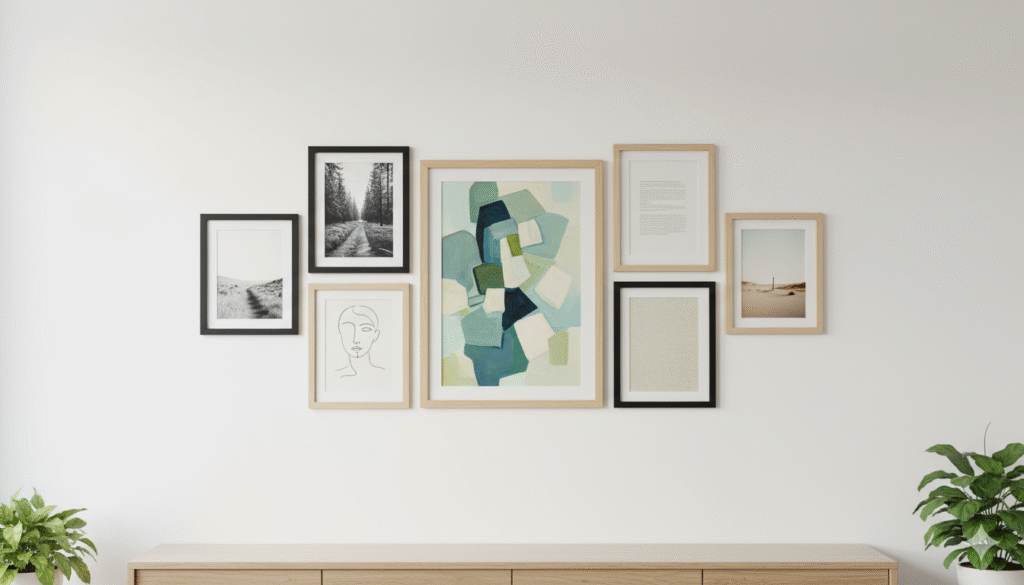
Special Applications: Academic and Scientific Posters
While artistic and commercial posters prioritize visual impact, scientific and academic conference posters follow strict readability requirements.
Text Size and Viewing Distance
Academic posters are designed for rapid information transfer. Viewers should be able to read key information from several feet away, which requires much larger text than typical graphic design.
Legibility Guidelines:
- Title: 72-100 point font (readable from 20-30 feet)
- Headers: 48-60 point font (readable from 15-20 feet)
- Body text: 24-32 point font (readable from 3-6 feet)
- Captions: 18-24 point font (readable from 2-4 feet)
Standard academic poster sizes include 36×48, 42×56, and 48×60 inches—larger than typical commercial posters to accommodate extensive data, charts, and graphs.
Frequently Asked Questions About Poster Sizes
What is the most common poster size?
The 24×36 inch poster is the most popular standard size worldwide. It offers maximum visual impact while remaining practical for shipping and display. Frames are widely available, and it matches the 2:3 aspect ratio used by most digital cameras and design software.
What size frame do I need for a 24×36 poster with a mat?
Without matting, you need a 24×36 frame. With a 2-inch mat border, you’ll need a 28×40 frame (24 + 4 inches wide, 36 + 4 inches tall). With a 3-inch mat, you’ll need a 30×42 frame. Always add double the mat width to each dimension.
How do I avoid my print getting cropped when ordering a poster?
Ensure your design’s aspect ratio matches your chosen poster size. An 18×24 design (3:4 ratio) won’t fit 24×36 dimensions (2:3 ratio) without cropping. Use aspect ratio calculations (width ÷ height) to verify compatibility before printing. Professional design software includes preset canvas sizes for standard poster dimensions.
What resolution do I need for a 40×60 poster?
For a 40×60 inch poster at 300 DPI, you need a 12,000 × 18,000 pixel image—approximately 216 megapixels. For outdoor viewing from a distance, 150 DPI (6,000 × 9,000 pixels) often suffices. Always consult your printer’s specific requirements.
Is A1 the same as 24×36?
Not exactly. A1 measures 594 × 841 mm (23.4 × 33.1 inches), making it slightly smaller than the US standard 24×36. While they’re often used interchangeably, precise framing requires the correct dimension. A1 uses the √2 aspect ratio (1:1.414), while 24×36 uses 2:3.
What’s the difference between a poster and a print?
“Poster” typically refers to promotional or decorative material printed on standard paper stock, while “print” often implies higher-quality fine art reproductions on premium paper or canvas. However, the terms are often used interchangeably. The critical difference is usually print quality, paper stock, and artistic intent rather than size.
Can I print a small image at poster size?
Technically yes, but quality will suffer dramatically. A typical smartphone photo (12 megapixels) produces a high-quality print up to about 10×13 inches at 300 DPI. Enlarging beyond that creates visible pixelation. For creating realistic art, start with high-resolution source material or work digitally at final print dimensions.
What size poster should I hang above my couch?
Your poster should be about 60-75% of your couch’s width. For a standard 84-inch (7-foot) couch, aim for artwork 50-60 inches wide—making a 40×60 or multiple pieces in a gallery wall arrangement ideal. Hang the center of your artwork at eye level, about 57-60 inches from the floor.
Do I need to use a mat with my poster frame?
Matting is optional but recommended for several reasons. It creates visual separation between the artwork and frame, provides an elegant gallery aesthetic, and prevents the print from touching the glass, which can cause damage over time. Most professional galleries use matting for these protective and aesthetic benefits.
What’s the best poster size for an event?
For indoor events, 18×24 or 24×36 posters provide excellent visibility. For outdoor promotion, 27×40 or larger ensures readability from a distance. Consider your viewing environment: hallways and interior walls suit medium sizes, while outdoor displays require larger formats. Understanding color psychology helps your event posters attract attention effectively.
Conclusion: Choosing the Perfect Poster Size
Selecting the right poster size depends on your specific needs—whether you’re creating art prints, promotional materials, or home décor. The most popular dimensions remain 18×24 and 24×36 inches for their versatility and readily available framing options.
Remember these key principles:
- Match your aspect ratio to prevent unwanted cropping
- Maintain 300 DPI resolution for professional print quality
- Calculate matting carefully by doubling the mat width and adding to both dimensions
- Consider international standards if selling globally
- Scale appropriately for your display space and viewing distance
Whether you’re working with US Imperial sizes or international ISO 216 standards, understanding poster dimensions, print resolution, and proper framing transforms good ideas into professional presentations. The technical knowledge outlined in this guide ensures your posters look sharp, professional, and perfectly suited to their purpose.
For artists expanding their practice, mastering poster sizes is just one element of professional art development. Combined with solid design principles and technical expertise, you’ll create compelling printed work that stands out in any environment.
Citations:
- Marler Haley – Poster Size Guide: Poster Dimensions Explained – https://marlerhaley.co.uk/blogs/news/poster-paper-sizes
- Frame Destination – Standard Poster Sizes Complete Guide – https://www.framedestination.com/blog/resources/the-most-common-poster-sizes
- PosterBurner – The Definitive Guide to Image Aspect Ratio for Printing – https://www.posterburner.com/Blog/BlogPost/Image-Aspect-Ratio-For-Printing/
- Atlas Wood Company – Matting Made Simple: How to Choose the Right Size – https://atlaswoodcompany.com/blogs/news/matting-made-simple-how-to-choose-the-right-size-for-your-frame
- OMG Kitty – Matting vs. No Matting: Frame Sizing Tips – https://omgkittyclub.com/blogs/blog/matting-vs-no-matting-frame-sizing-tips
- VSL Print – Digital Print Resolution: Optimal DPI & Image Size – https://www.vslprint.com/printing-nyc/digital-printing/whats-the-resolution-of-digital-prints-optimal-dpi-image-size-for-quality/
- Pixel Gallery – The Ultimate Guide to Understanding DPI for High-Quality Art Prints – https://pixel-gallery.co.uk/blogs/pixelated-stories/understanding-dpi-for-high-quality-art-prints
- Gold Image Printing – A Guide To Standard Poster Sizes – https://www.goldimageprinting.com/content/standard-poster-size.html
- Thomas Group Printing – The Ultimate Guide to Standard Poster Sizes & Dimensions – https://thomasgroupprinting.com/standard-poster-sizes/
- PrintSafari – Standard Poster Sizes | PrintWiki – https://www.printsafari.com/pages/printwiki/most-common-poster-sizes/
- XL Displays – A Paper Sizes Explained – https://www.xldisplays.co.uk/pages/A-Paper-Sizes-Explained.aspx
- University of Cambridge – A4 paper format / International standard paper sizes – https://www.cl.cam.ac.uk/~mgk25/iso-paper.html
- Chicago Printworks – What is Aspect Ratio? – https://www.chicagoprintworks.com/resource-posts/what-is-aspect-ratio
- Rockbrook Camera – Understanding Aspect Ratio For Better Prints – https://www.rockbrookcamera.com/blogs/news/understanding-aspect-ratio-for-better-prints
- Poster Print Shop – Everything You Need to Know About DPI for Large Format Printing – https://posterprintshop.com/guide/how-many-dpi-for-large-format-printing/
- Picture Salon – Standard Frame Sizes – https://www.picturesalon.com/standard-frame-sizes
- Frame Amo – Complete Guide to Selecting the Perfect Frame and Mat Sizes – https://frameamo.com/blogs/blog/guide-to-selecting-the-perfect-frame-and-mat-sizes
- Frame Amo – 18×24 Frame Sizing Guide – https://frameamo.com/blogs/how-tos-and-tutorials/18×24-frame-sizing-guide-how-to-mat-and-display-your-18×24-artwork
- Frame Destination – Guide to Frame and Mat Dimensions for Common Print Sizes – https://www.framedestination.com/blog/picture-frames/guide-to-frame-and-mat-dimensions-for-common-print-sizes
- Japandi.Art – The Ultimate Guide to Choosing Poster Sizes for Your Space – https://japandi.art/blogs/japandi/ultimate-guide-to-choosing-poster-sizes-for-your-space
- UC Davis – Poster Design Principles & Tips – https://urc.ucdavis.edu/sites/g/files/dgvnsk3561/files/inline-files/General%20Poster%20Design%20Principles%20-%20Handout.pdf
- Orbit Media – 3 Types of Search Intent in One Diagram – https://www.orbitmedia.com/blog/types-of-website-visitors/

